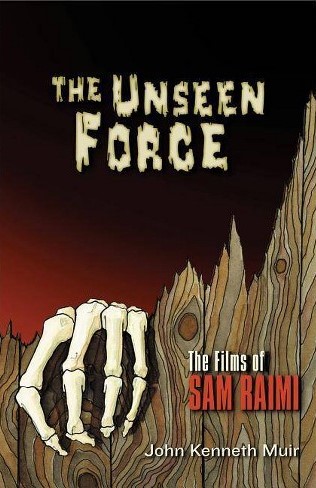By JOHN KENNETH MUIR (Applause; 2004)
The first book devoted entirely to the life and films of Sam Raimi. THE UNSEEN FORCE was published in 2004, and so only covers Raimi’s filmography up to the then in-production SPIDER-MAN 2 (meaning SPIDER-MAN 3, DRAG ME TO HELL, OZ THE GREAT AND POWERFUL and DR. STRANGE IN THE MULTIVERSE OF MADNESS are missing). It’s worthwhile nonetheless, offering a thorough overview of its subject and his early output.
As is often the case with books like this one, the author is excessively reverential toward his subject. Every one of Raimi’s pre-2004 films, according to John Kenneth Muir, is a masterfully crafted breakthrough, although Muir is most interested in the totality of Raimi’s work, and an arc that, beginning with low budget horror-fests that gave way to the more stately likes of THE GIFT and SPIDER-MAN, has steadily matured (although how mature SPIDER-MAN truly is remains a matter of debate).
Raimi’s early super 8mm shorts, which marked his true start in the business, aren’t covered, but we do get plenty of info on WITHIN THE WOODS, the 1978 mini-feature that inspired THE EVIL DEAD. The latter was Raimi’s debut feature, and its production and reception have been voluminously covered elsewhere (such as evildeadarchives.com and the numerous DVD/Blu-ray releases). That means Muir’s history of the film and its 1987 sequel, while extremely thorough, are neither comprehensive nor unprecedented.
Far more edifying are the chapters on less iconic Raimi productions like his much-derided second feature CRIMEWAVE, whose many production issues are enumerated here; his first big studio production DARKMAN, whose once-groundbreaking special effects are given plenty of coverage; and the “unique and stylish” neo-western THE QUICK AND THE DEAD, on which Raimi’s input was trumped by that of its star Sharon Stone. Many cast and crewmembers (including actors Gary Cole, Willem Dafoe and Cliff Robertson, screenwriter Simon Moore and composer Christopher Young) are interviewed by Muir, although Raimi himself is heard from only via archival sources.
Of Raimi the man we learn very little outside the already known: that he’s a hell of a nice guy (J.R. Bookwalter, who wrote about his interactions with Raimi in the book B-MOVIES IN THE NINETIES AND BEYOND, had a different take) whose boyish enthusiasm is infectious, and that he has a lifelong passion for the Three Stooges. Raimi was and remains an extremely private individual, and Muir, for better or worse, respects that privacy.

